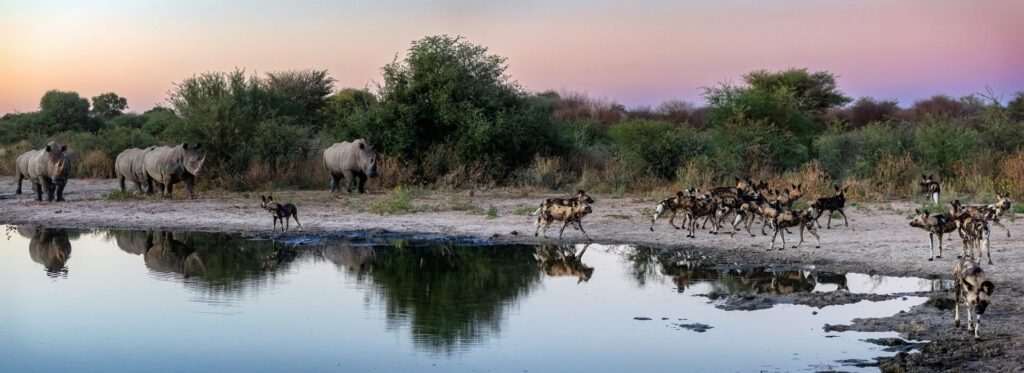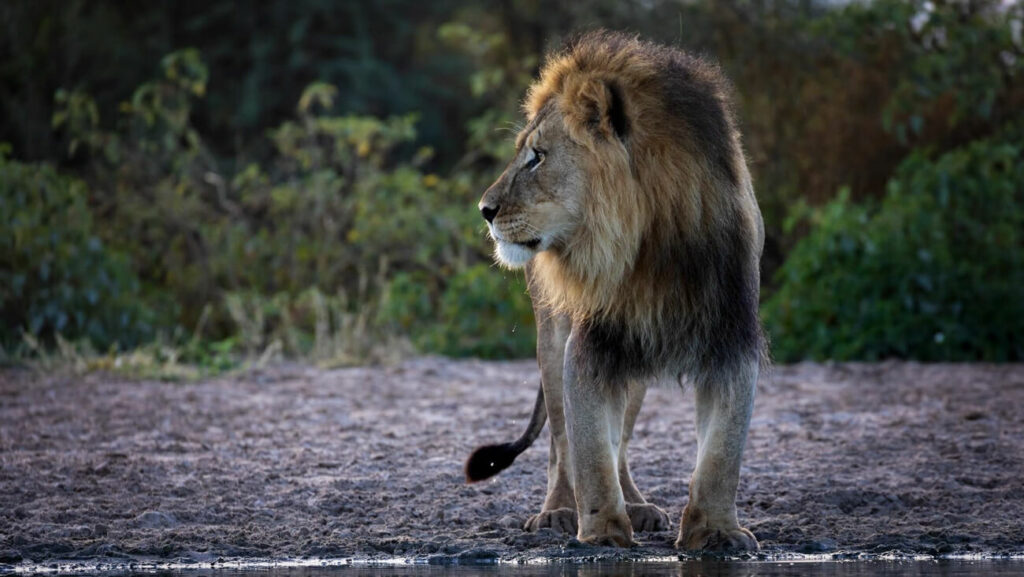Join Our African Wild Dog Monitoring Safari
Wild Dog Monitoring Safari: Conservation Begins with Understanding
African wild dogs (Lycaon pictus), with their swirling coats and captivating social bonds, are among Africa’s most iconic – and tragically, most endangered – predators. We call them ‘painted wolves’ out of admiration for their unique markings, but African wild dogs are neither wolves nor painted by anyone but nature. Once an estimated half a million African wild dogs roamed the continent, now a mere 6 500 individuals remain. Join our crucial mission to monitor these fascinating creatures, unlocking new insights that will not only drive their conservation but inform broader efforts to protect fragile ecosystems.
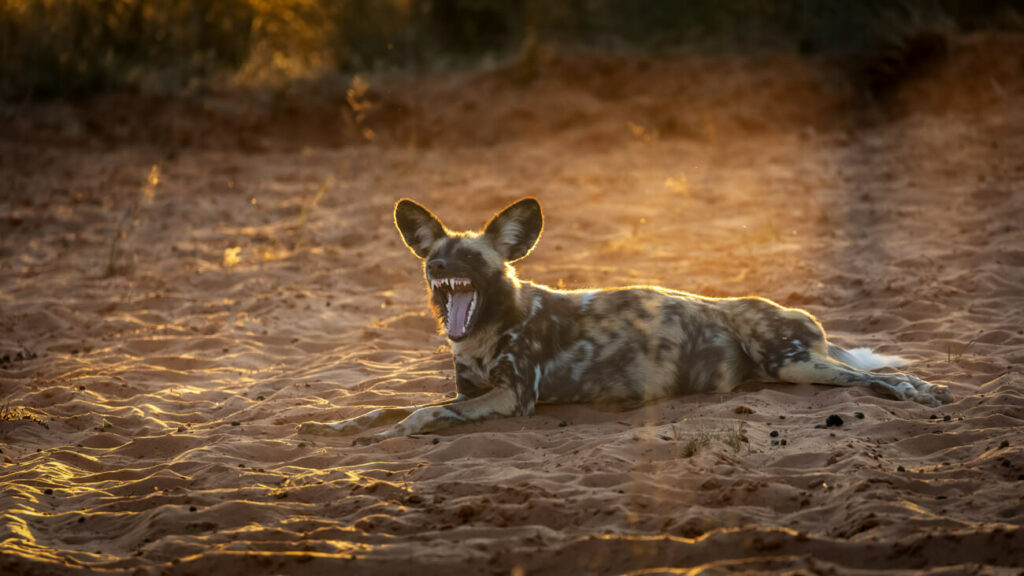
Book Now
Beyond the Painted Wolf: Demystifying the African Wild Dog
Naming
Once nicknamed “Cape hunting dogs,” the scientific name Lycaon pictus translates to “painted wolf-like,” reflecting their unique appearance with striking, multi-colored coats. Despite their name and appearance, African wild dogs are not direct relatives of domestic dogs or wolves. Instead, they belong to their own distinct genus, Lycaon.
Evolution
Diverging from other canids over a million years ago, African wild dogs are evolutionary marvels, their lineage hinting at early pack-hunting strategies.
Appearance
Weighing 44-77 lbs (20-35 kg) and standing 24-30 inches (60-75 cm) tall, their mottled coats act as camouflage. Their fur boasts a unique pattern of black, white, tan, and yellow blotches, making each individual distinctive. Large, rounded ears, long legs, short muzzles, and bushy tails with a characteristic white tip distinguish their look.
Incredible Athletes
Capable of sprints up to 44 mph (71 km/h) and long chases, they’re among Africa’s top endurance hunters. Their long legs, streamlined bodies, and large hearts grant them incredible endurance, allowing them to tirelessly pursue prey over long distances.
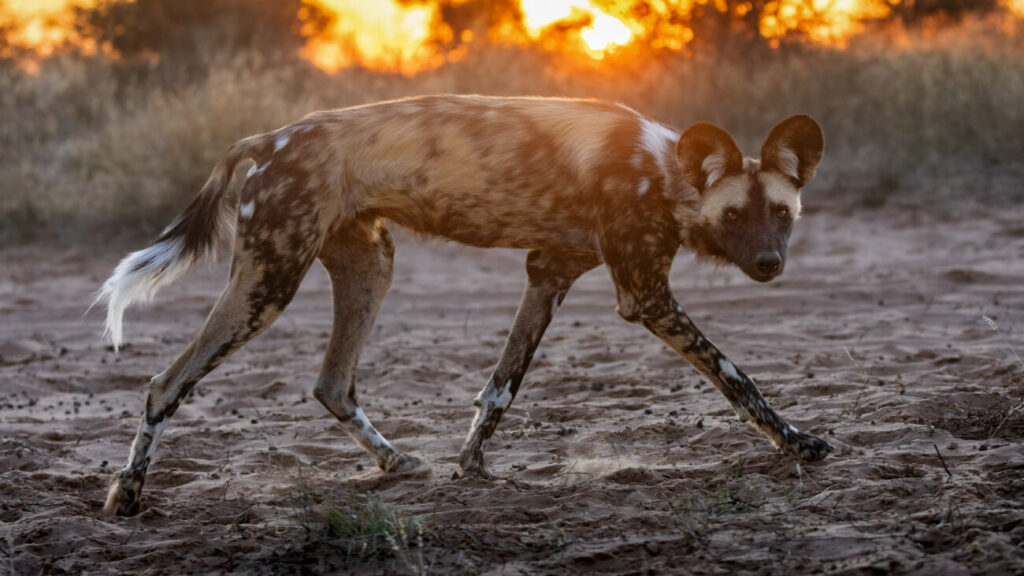
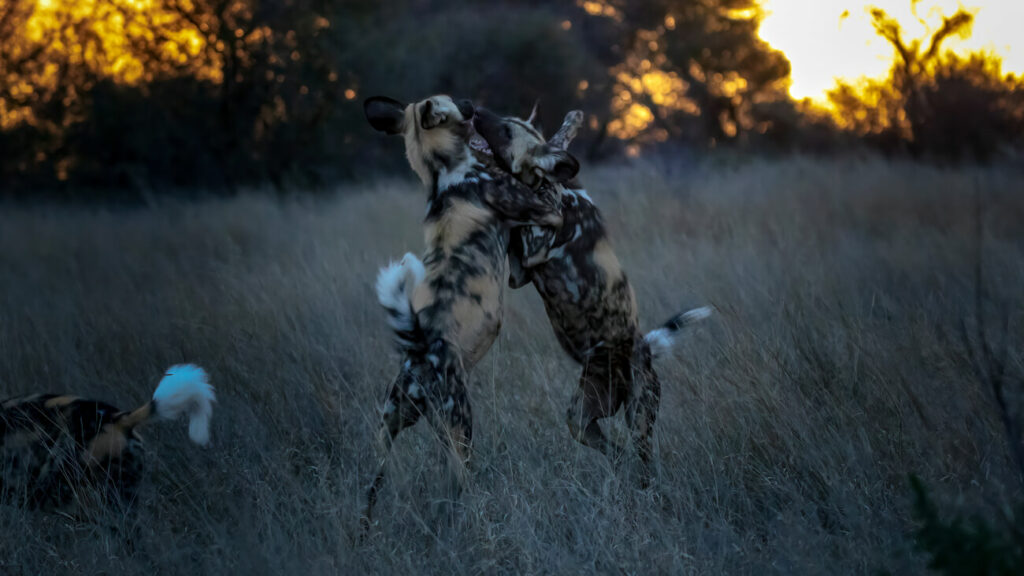
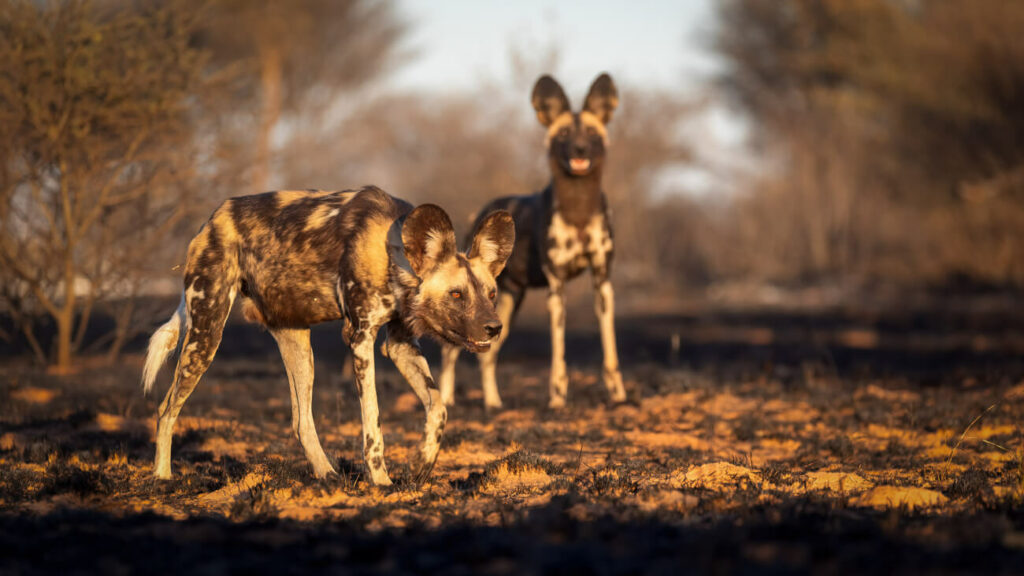
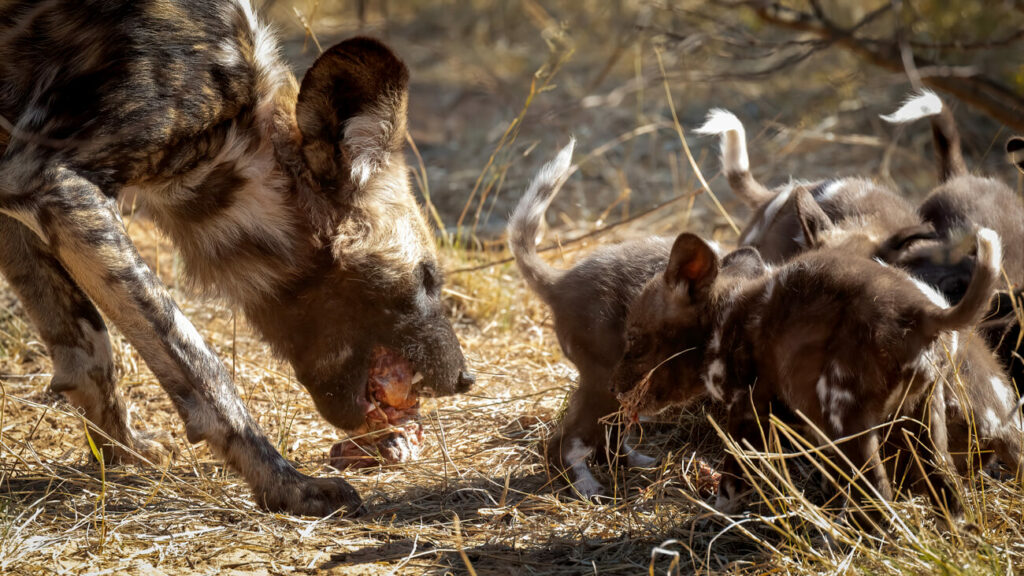
The Power of the Pack: Why Wild Dog Social Life Matters
Cooperative Care
The entire pack raises pups, from feeding to providing defense. This strengthens group survival.
Pack Dynamics
African wild dogs are highly social animals living in close-knit packs typically ranging from 6-20 adult individuals. Pack life centers around the dominant breeding pair, with other pack members cooperatively hunting, raising pups, and defending their territory.
Hierarchy and Communication
African wild dogs maintain a distinct social hierarchy with the alpha male and female leading the pack. They communicate through various vocalizations, body language, scent cues, and even elaborate greeting ceremonies that reinforce social bonds create a tight-knit society. Observing this fascinates and informs human understanding of social intelligence.
Cooperative Hunting
These canids are skilled cooperative hunters, employing strategies to successfully take down prey much larger than themselves. Their hunts are characterized by relentless chases, coordinated attacks, and efficient consumption of their kill.
African Wild Dog Safari: Wild at Heart, Precarious Existence
Temperament
Curious, bold, yet not inherently aggressive toward humans, conflict generally arises when defending territory or kills.
Reproduction
African wild dogs breed seasonally with only the alpha female typically producing pups. If conditions are suitable with prey abundant, they can den twice in a year with Beta and/or Charlie females birthing too. After a 70 day gestation period, litters range from 2-20 pups, born in a communal den site (typically an abandoned aardvark or porcupine burrow). The entire pack participates in raising, feeding, and protecting the pups. This high output is counterbalanced by high pup mortality in the wild.
Historical Loss
Once found across most of sub-Saharan Africa, they now inhabit scattered pockets at a fraction of their original range, with strongholds in southern and parts of eastern Africa. Wild dog monitoring and research throughout Africa shows that this is the primary cause for the rapid decline of their numbers throughout the continent as, unlike most of the other carnivores, wild dogs require large contiguous land with large enough prey populations to sustain their impact.
Available Habitat
While the size of land needed is subject to many variables, and perhaps less than the common rhetoric, the truth is that most of Africa has been fragmented into private properties for agricultural, mining, industrial, or other purposes. Much of Africa’s wilderness areas are divided into smaller areas, and the few that are large enough and willing to sustain African wild dogs, are likely already home to the and unable to accommodate more.
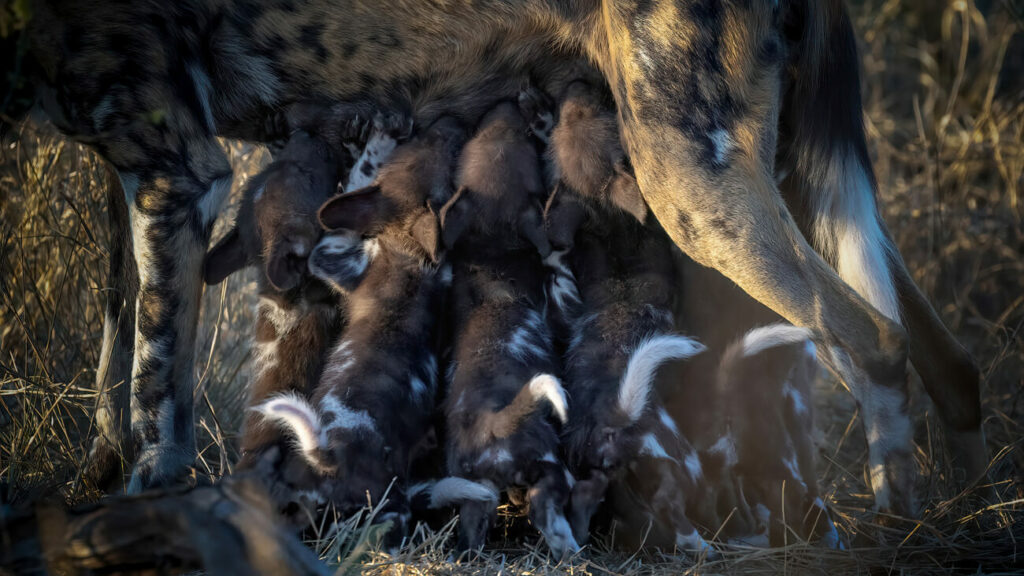
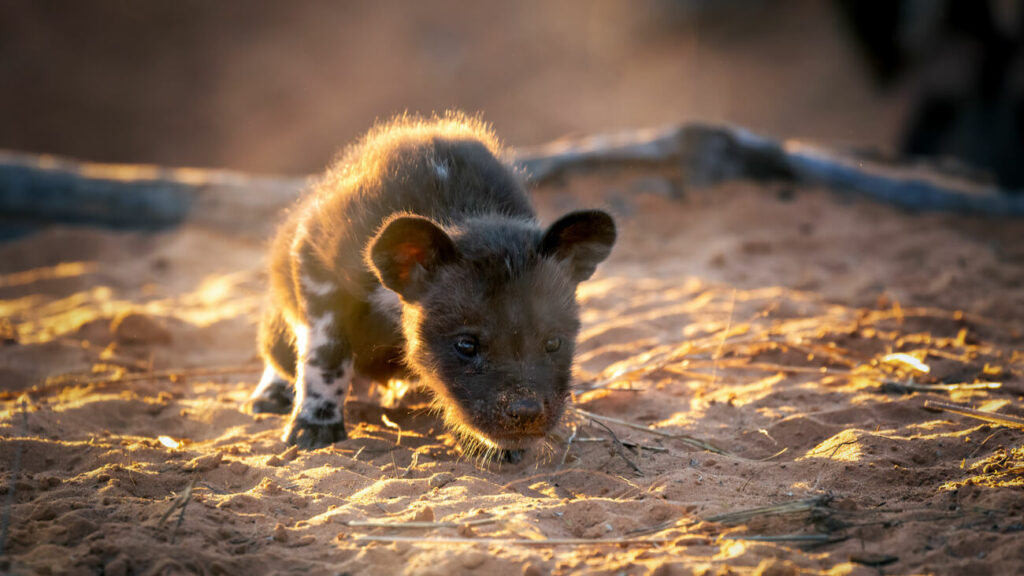
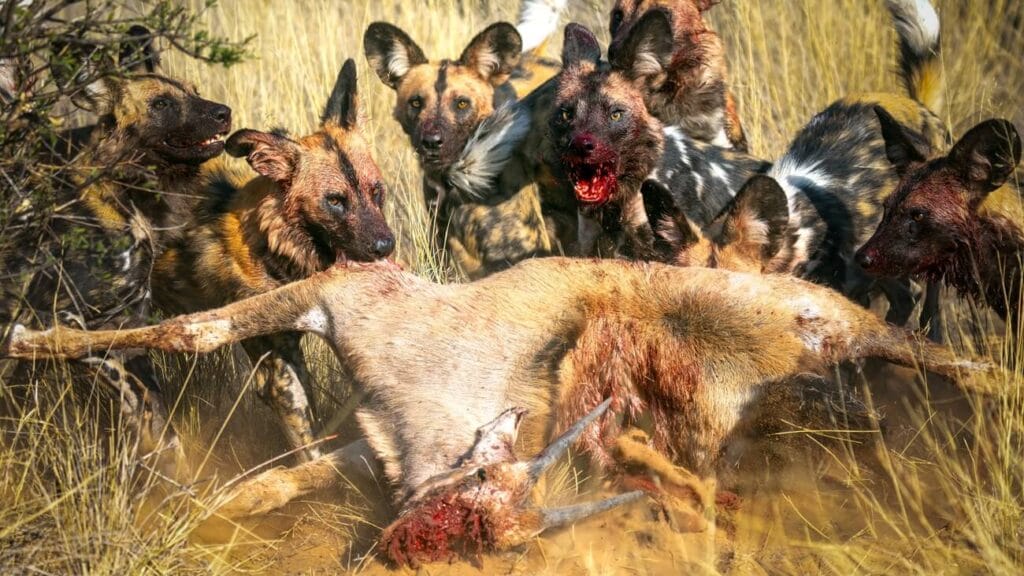
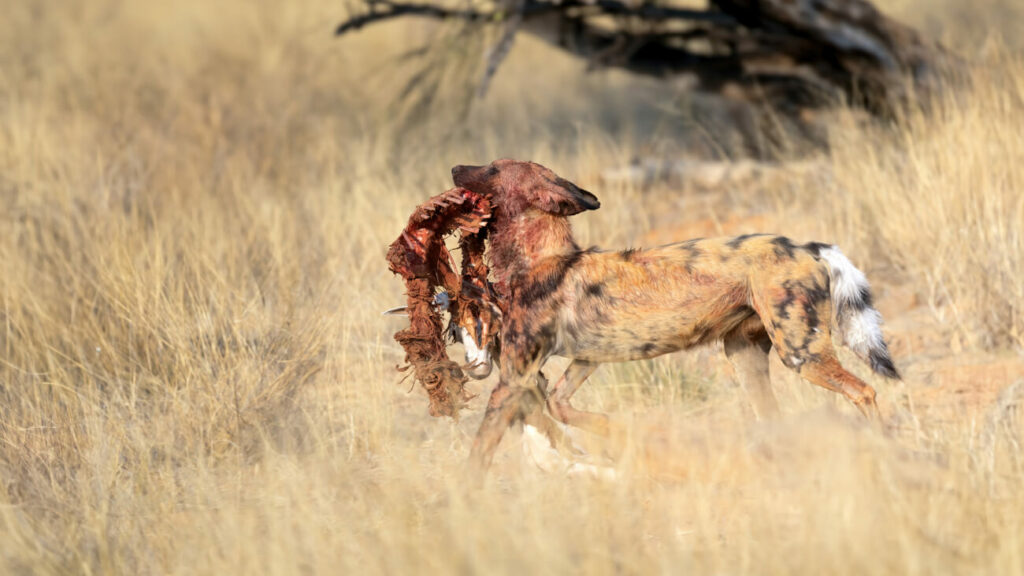
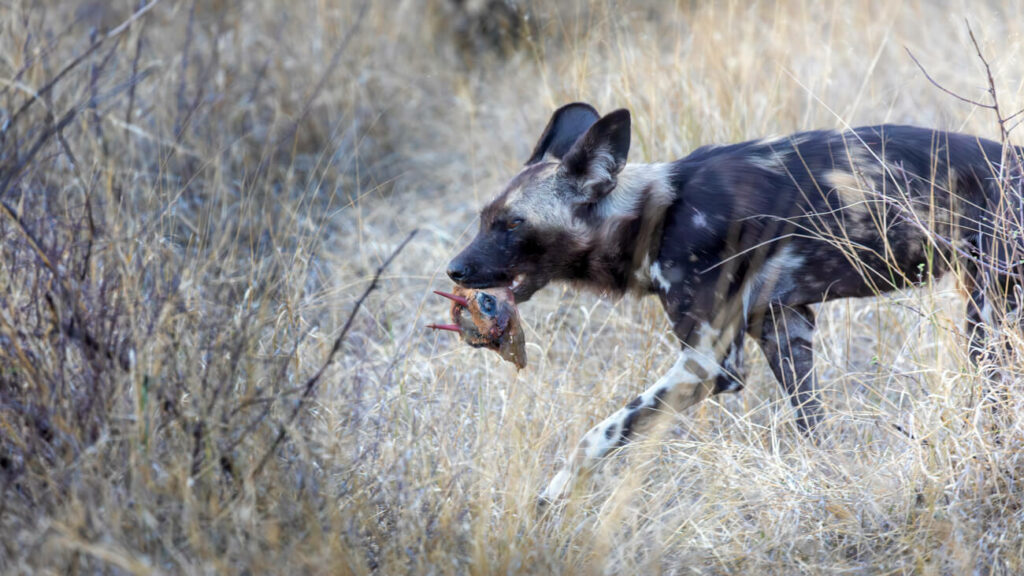
Diet & Ecology
Highly effective cooperative hunters targeting medium-sized ungulates, their prey choices impact biodiversity and balance the savanna ecosystem. They commonly target medium-sized antelopes like impala, as well as other species like wildebeest, warthog, and even larger prey like zebras. Unlike most areas, African wild dogs on Khamab Kalahari Reserve favor large prey: Oryx are their mainstay, and we’ve even observed successful adult ELAND hunts – something rarely seen across Africa. This makes this population fascinating to monitor and study.
Hunt Success Rate
Often considered on of Africa’s most proficient hunters with a success rate of over 80%, our observations from African wild dog monitoring on Khamab Kalahari Reserve differ, perhaps in accordance with the abovementioned prey preference. The Eastern Kalahari Bushveld is not home to impala or nyala and the more arid environment allows for smaller kudu populations than elsewhere. This leaves African Wild Dogs with few small antelope or easy prey to hunt as neither springbok nor steenbok are ideally suited to their hunting style, even if they do successfully catch them from time to time. Most of the antelope are medium-large with both sexes bearing ferocious horns.
However, African wild dogs are smart animals and once they work out how to do something, they are quick to make a habit of it. On Khamab Kalahari Reserve, our observations from wild dog monitoring are a clear Gemsbok preference.
Kill Frequency
African Wild Dogs have a reputation for being daily hunters with some packs knowns to kill multiple animals in a day. While kill frequency is subject to pack sizes, it is also subject to prey sizes. It’s easy to see how a pack of 30 cannot be fed by a single impala. Because African wild dogs are hunting bigger prey here, they are hunting less frequently. Even though African wild dogs have astonishingly fast metabolisms, they are seldom daily hunters out here. As they engorge themselves on larger antelope, so they lay around for longer periods digesting their food. If they aren’t moving, they aren’t burning calories.
The Endangered African Wild Dog: Threats They Face and Why We MUST Monitor
Habitat Loss & Fragmentation
As wilderness becomes farms and private land fragmented, pack territory shrinks, and conflict rises. African wild dogs are major victims of human-wildlife conflict as their available habitat shrinks, they are forced to venture into farmland, and cattle make for easy prey. Similarly, African wild dogs are hugely susceptible to outbreaks of rabies and canine distemper, and venturing through community land unvaccinated domestic animals can increase their risks. Often, it’s the other way around with community land bordering conservation areas, and infected domestic animals entering these reserves. Wild dog monitoring pinpoints hotspots. African wild dogs are classified as endangered by the IUCN with a decreasing population trend.
Persecution & Disease
Snares, shooting by farmers, and diseases transmitted by domestic animals take a devastating toll. Data informs protective action.
Small Populations = Big Trouble
Low genetic diversity puts wild dogs at greater risk on inbreeding. Wild dog monitoring and conservation efforts ensures a holistic picture of long-term viability.
Large Populations = Big Trouble
African wild dogs are efficient pack hunters, but their impact on prey can become unsustainable when their numbers surge due to a unique combination of factors. Breakaway dogs frequently form new packs, doubling the hunting pressure on prey species across vast areas as they seldom follow roads and can travel great distances. Furthermore, females can have litters of up to 20 pups, quickly amplifying the population. This complex dynamic makes monitoring essential to understand their distribution, pack sizes, and prey consumption, ultimately ensuring a balanced ecosystem. Without close monitoring, an unchecked rise in wild dog numbers could lead to overhunting and a collapse of the prey base, with dire consequences for the entire Kalahari. Wild dog monitoring is therefore essential.
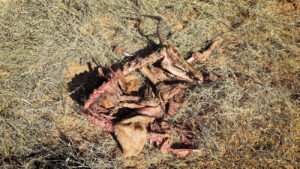
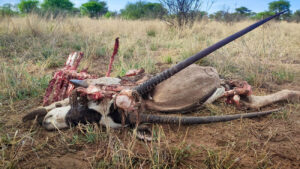
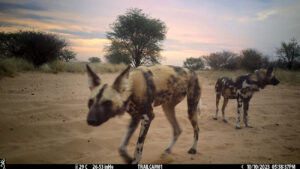
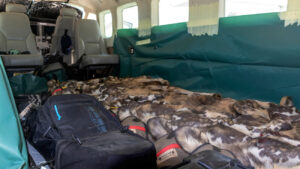
Why Monitor African Wild Dogs? The Vital Role of Research and Monitoring
Research plays a crucial role in African wild dog monitoring. By studying their populations, movements, social dynamics, and ecological interactions, we gain a deeper understanding of their needs and the threats they face on Khamab Kalahari Reserve. This information gathered from wild dog monitoring informs effective management strategies on the reserve, and guides decisions to possibly translocate wild dogs to other areas in Africa for the conservation of the species.
Your Wild Dog Tracking Experience: An Unforgettable Adventure
Imagine this: the sun rises over the vast Kalahari landscape, painting the sky in hues of orange and pink. You’re in an open-top game viewing (safari) vehicle, the crisp morning air filling your lungs, anticipation hanging heavy in the air. Today, you’re on the trail of one of Africa’s most endangered predators – the African wild dog.
How We Track These Elusive Hunters
Our pursuit begins with cutting-edge technology created in 1973 called GPS. Each pack we monitor has a designated individual fitted with a specialized GPS collar. These collars transmit location data at preset times or intervals, strategically chosen for when the dogs are most likely to be resting or less active. Why? Because these incredible creatures can cover vast distances – up to 50 kilometers in a single day!
But technology isn’t our only tool. We’ve strategically placed camera traps throughout the reserve to help us locate uncollared wild dog groups. These cameras provide valuable insights into their movements and behaviors, further enhancing our monitoring efforts.
Khamab Kalahari Reserve, our sprawling 240,000-acre backyard, presents a unique challenge. It’s a single, vast, free-roaming area, meaning the dogs can be anywhere at any time. Once we receive a GPS point, the search begins! We navigate the rugged terrain, relying on our expertise and the thrill of the pursuit to begin our wild dog monitoring activity. The lack of traversing and time limits makes Khamab Kalahari Reserve the best place to see African wild dogs.
Telemetry and Spoor: A Dynamic Duo
Upon reaching the general location, we switch to VHF telemetry, a powerful tool that helps us pinpoint the dogs’ exact position using a low-powered frequency that is continuously transmitted from the dog’s collar. But the Kalahari throws us a curveball. The dry air, flat terrain, and iron oxide-rich soil limit the VHF range significantly. We often have to rely on our tracking skills, following their spoor (tracks) to increase our chances of a successful encounter.
A Day in the Life of a Wild Dog Tracker
In an ideal scenario, we aim to locate the same pack twice a day – morning and afternoon. The challenge to effective wild dog monitoring is in consistency, but the Kalahari has a mind of its own. Factors like the dogs’ location, their recent hunting activity, the season, and even the moon cycle influence our tracking strategy.
Summer months bring scorching heat, making early mornings and late evenings the prime times for wild dog activity. Winter (June – September) offers cooler temperatures and drier conditions, perfect for off-road exploration.
Unraveling the Mysteries of Wild Dog Behavior
Once we find the pack, the real wild dog monitoring adventure begins. We follow them, observing their intricate social dynamics, hunting strategies, and prey selection. As African wild dogs have a unique social hierarchy, led by a dominant alpha pair, it’s amazing to watch how they interact, how they cooperate on hunts, and how they care for their young.
Are they opportunists, chasing whatever crosses their path? Or do they exhibit selective hunting behavior, targeting specific prey? Every moment is a learning opportunity, a chance to unravel the mysteries of these fascinating creatures, and the only way to answer these questions is through effective wild dog monitoring.
The Kalahari Advantage: A Wild Dog Monitoring Paradise
The Kalahari’s unique ecosystem makes it an ideal habitat for African wild dog monitoring. Lower densities of competing predators, like spotted hyenas, increase the dogs’ chances of hunting success and pup survival. The flat, open terrain also makes it easier for us to track endangered wild dogs in the Kalahari and observe them, providing invaluable data for their conservation.
Ethical Observation: A Respectful Approach
Our African wild dog monitoring program is strictly observation-based. Unlike some “voluntourism” outfits that allow petting or captive breeding, we believe in ethical and respectful wildlife interactions. We never intervene in their natural behaviors, and we can’t guarantee sightings or specific interactions. The wild dogs are truly wild, and that’s what makes this experience so special.
Contributing to Conservation
The data we collect during these wild dog monitoring tracking sessions isn’t just about wild dogs. It feeds into the broader conservation and ecological management strategies of the entire reserve. By understanding the intricate relationships between predators, prey, and their environment, we can make informed decisions that benefit the entire ecosystem. For this reason, African wild dog monitoring is typically conducted year-round.
Unexpected Encounters and Unforgettable Moments
The beauty of wild dog tracking lies in its unpredictability. You never know what you might encounter along the way – a stealthy leopard, a tower of giraffes, or a crash of rhinos. And, of course, there’s nothing quite like witnessing the raw power and agility of a wild dog pack on the hunt.
Join the Pursuit: Book Your Wild Dog Monitoring Adventure
Ready to experience the thrill of African wild dog monitoring in the Kalahari? Join us on an African wild dog conservation safari that will leave you breathless and contribute to the preservation of this magnificent species.
Ready to Make a Difference? Begin Your Wild Dog Monitoring Journey? Contact us today!
More questions, read our FAQs
More FAQ’s
Our Location
